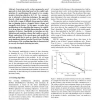Free Online Productivity Tools
i2Speak
i2Symbol
i2OCR
iTex2Img
iWeb2Print
iWeb2Shot
i2Type
iPdf2Split
iPdf2Merge
i2Bopomofo
i2Arabic
i2Style
i2Image
i2PDF
iLatex2Rtf
Sci2ools
CEC
2005
IEEE
2005
IEEE
Improvements to the scalability of multiobjective clustering
In previous work, we have proposed a novel approach to data clustering based on the explicit optimization of a partitioning with respect to two complementary clustering objectives [4, 5, 6]. In a comparison to alternative clustering techniques, the approach showed a high performance in terms of its capability to deal with a range of difficult data properties, including overlapping clusters, elongated cluster shapes and unequally sized clusters. In this paper, we make three modifications to the algorithm that improve its scalability to large data sets with high dimensionality and large numbers of clusters. Specifically, we introduce new initialization and mutation schemes that enable a more efficient exploration of the search space, and modify the null data model that is used as a basis for selecting the most significant solution from the Pareto front. The high performance of the resulting algorithm is demonstrated on a newly developed clustering test suite.
Alternative Clustering | Artificial Intelligence | CEC 2005 | Complementary Clustering Objectives | Data Clustering |
Related Content
| Added | 24 Jun 2010 |
| Updated | 24 Jun 2010 |
| Type | Conference |
| Year | 2005 |
| Where | CEC |
| Authors | Julia Handl, Joshua D. Knowles |
Comments (0)

